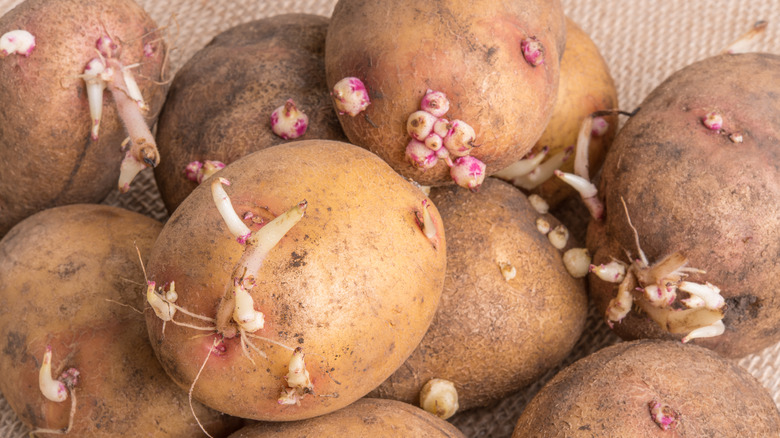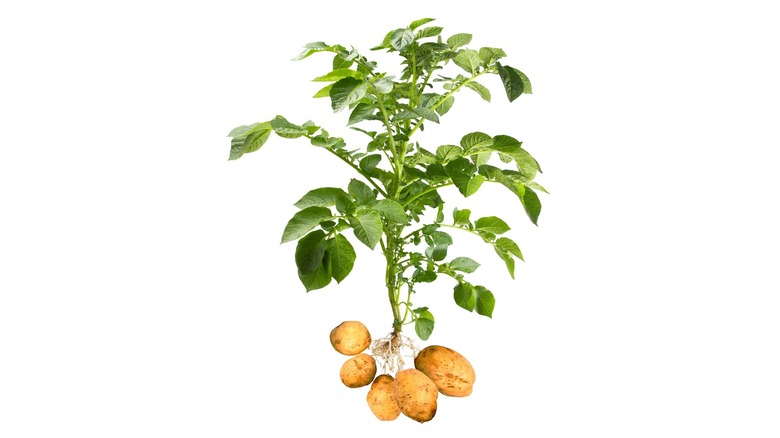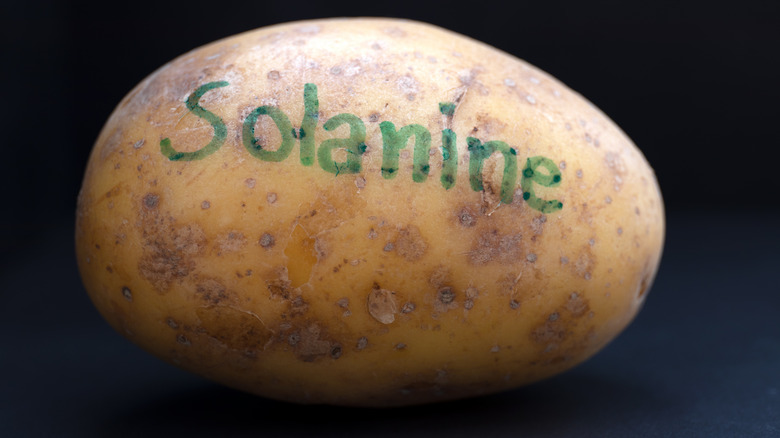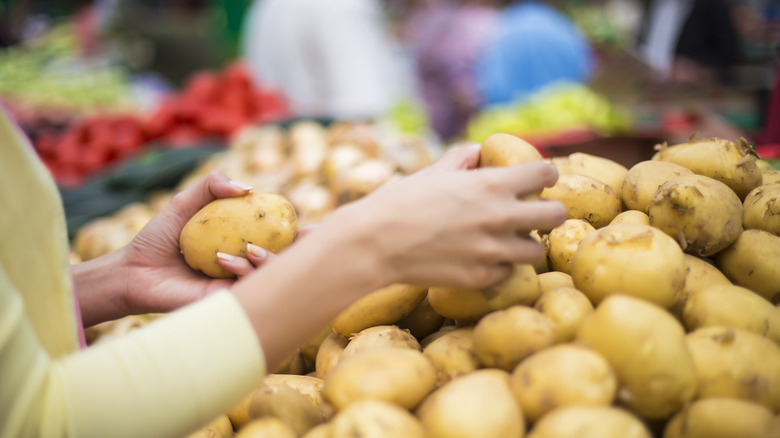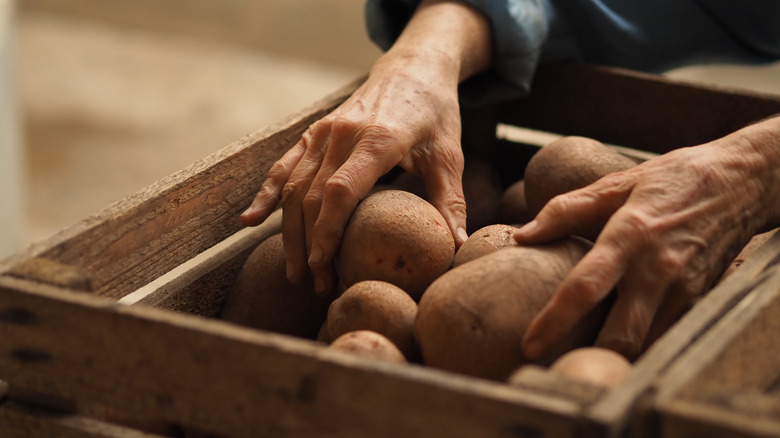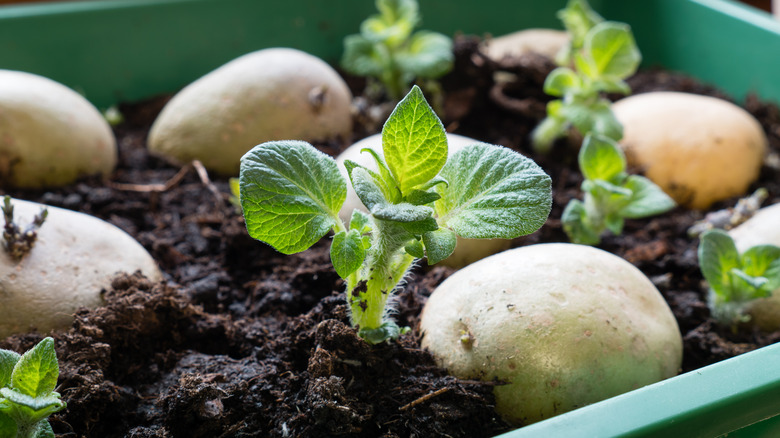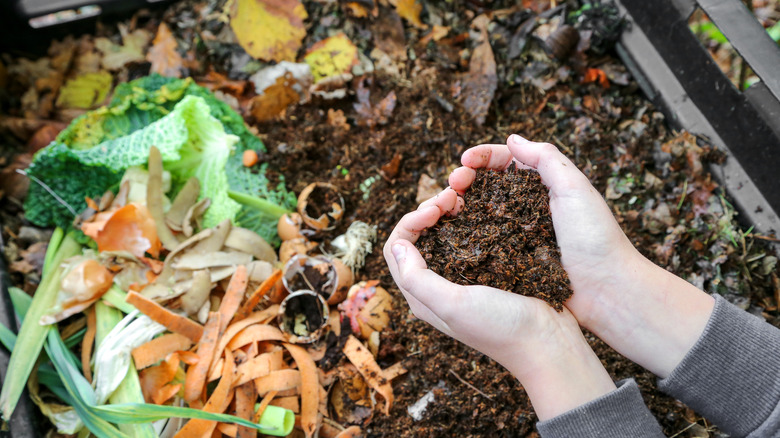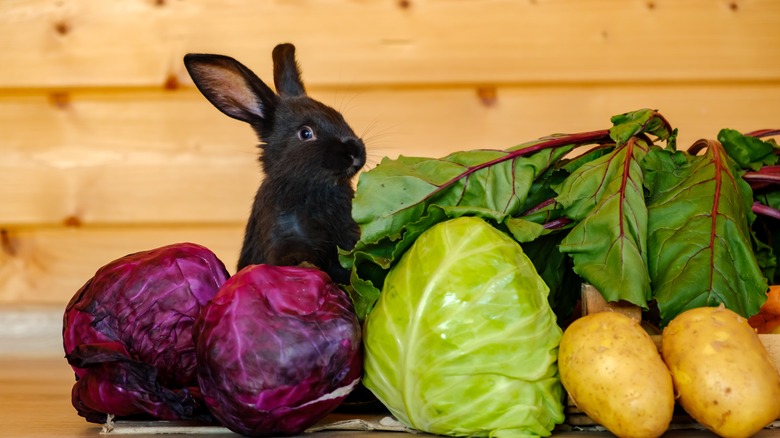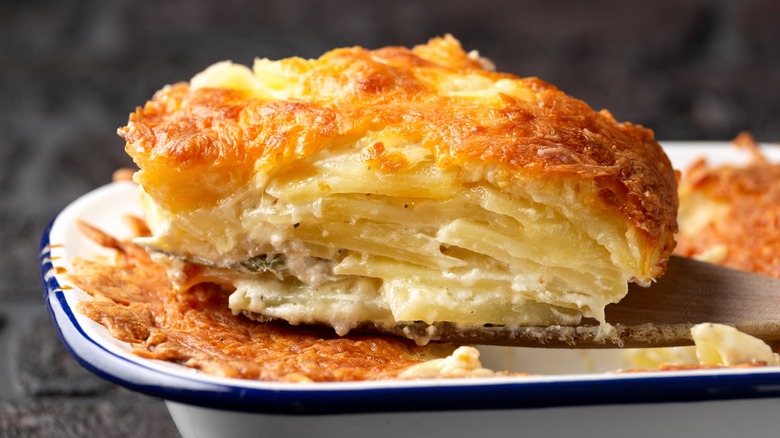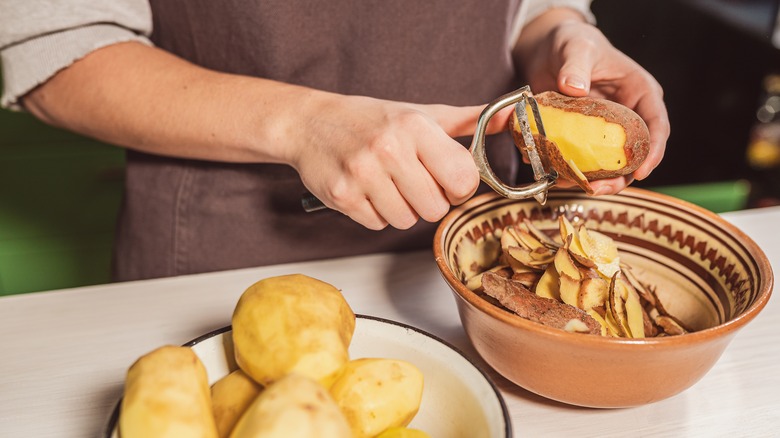The Ultimate Guide To Sprouted Potatoes
We may receive a commission on purchases made from links.
Rushing to make dinner, you reach into your vegetable drawer and pull out a sack of sprouted potatoes. The plan was roast beef with mash, but now you're not sure if these sprouted potatoes are safe to eat. You're right to wonder.
Consider this: In 1983, 109 students in Alberta ate baked potatoes for lunch in their school cafeteria, according to the Smithsonian Magazine. While swallowing their spuds, some pupils noted a burning sensation in their throats. Just minutes later, 61 complained of stomach aches and other symptoms of food poisoning. Later, the victims reported that the baked potatoes had a greenish tint and bitter taste. There was no sign of a bacterial, viral, or fungal perpetrator meaning the potatoes themselves were the culprits. All the children recovered within hours of their unwholesome lunch.
In that instance, no permanent damage occurred, but the moral is clear: potatoes can be dangerous. Cooks and diners can easily avoid illness, though, by learning more about sprouted potatoes. Here's everything you need to know.
What is a sprouted potato?
It's not hard to spot a sprouted potato. They're the ones with white bulges bursting out of them. No, as much as it may look like it, this is not some kind of alien parasite trying to attack you by disguising itself as food — it's just a part of the potato plant's normal growth cycle.
According to an open-source botany textbook by SUNY Geneseo, wild potato plants rely on tubers to survive from year to year. Although most gardeners plant Solanum tuberosum as an annual crop, in its natural habitat, this species grows perennially. At home, on the harsh mountainsides of the Andes, the top part of the plant dies off when the weather gets too dry and cold. The plant stores its energy as starch in bulbous potatoes underground. When the conditions are right — warm and moist — the underground tuber sends shoots up.
Potatoes hidden away in kitchen pantries sometimes do the same as their wild cousins — they detect summery conditions and start growing sprouts.
Potatoes also sometimes turn green when under certain conditions. According to John Seymour, author of "The New Self-Sufficient Gardener," this is because potatoes are scientifically classified as stems rather than roots. That means they can produce chlorophyll which tints them green when exposed to light. This is not the same as sprouting, although potatoes can both sprout and have a greenish hue at the same time.
Are sprouted potatoes poisonous?
When transatlantic explorers first returned to Europe with potatoes, some people suspected that the tubers could cause illnesses like leprosy, according to Smithsonian Magazine. They were wrong — potatoes won't give anyone skin sores. On the other hand, Poison Control says parts of the potato plants, like the sprouts on the tubers, contain solanine which is toxic to humans. It causes nausea, abdominal pain, and diarrhea, but no epidermal infections.
Every part of wild potato plants is poisonous, according to Smithsonian Magazine. This protects them from insects, animals, and humans who might want to chow down on their green fronds. Vicuñas, small, wild llamas, have learned to lick clay before eating the plants. Molecules in the soil combine with the plants' toxins and neutralize them. The First Nations of Peru and Bolivia imitated the woolly animals and dipped poisonous varieties of potatoes in clay before baking. Today, vendors in these countries still offer edible clay to make a traditional sauce, chaco, alongside potatoes in local markets.
Early altiplano farmers developed varieties of potatoes that could grow at many altitudes and climates. They bred the plants so the tubers were no longer poisonous.
Today, the potatoes in the grocery store produce sections are only dangerous if they're green — that indicates a high level of solanine — or sprouted.
Buying potatoes so they don't sprout
It's tempting to buy potatoes in bulk. They don't have a reputation for spoiling quickly and can be a lot cheaper this way. It's easy to find a 50-pound box of 80 huge Idaho russets on Amazon. That cuts down on excursions to the grocery store, but there's a downside to purchasing the vegetable this way — they could go green or sprout.
Michigan State University recommends only purchasing the number of potatoes you can use in one month. The tubers can keep for longer, depending on their freshness, but, this way, consumers know potatoes won't sprout before they can get them in the oven.
When you're in the produce aisle, check each potato carefully for nicks caused by farming equipment. The vegetables you choose should be free of bruises, injury, and mold. They should not show any signs of greening and have no sprouts on them.
Storing potatoes so they don't sprout
The Incan Empire depended on potatoes because grains don't grow well in the Andes mountains, says William McNeill, author of "How the Potato Changed History." This posed a problem because, unlike dry cereals, potatoes don't store well. Potatoes are prone to sprout, turn green, and rot. Fresh potatoes only last a few months.
The Incan solution was making chuño, a sort of freeze-dried potato. They left potatoes to freeze in the chilly night, then squeezed out the liquid. The arid mountain air-dried the preparation. Today, most people outside of South America don't make chuño — it's much easier to run to the grocery store for potatoes. Still, most have probably overbought at some point and found a sprouted potato in the pantry. Proper storage will reduce this issue.
Michigan State University recommends storing potatoes at 45 F to 50 F — that's slightly warmer than your fridge — in a dark, dry place. Moisture and warmth will cause them to sprout, and the light turns them green. In the right spot, they should last up to a month.
Modern inventions contribute to potatoes keeping for longer. According to The Journal of Food Science and Technology, most commercial growers spray potatoes with CIPC to suppress sprouting. Although potato sellers have used this chemical for decades, it's not clear if it could have a repercussion on consumer health. Some prefer buying organic, but without the treatment, potatoes will likely sprout even faster.
Planting sprouted potatoes
Seeing the green sprouts on potatoes makes it tempting to pop them in the soil. It seems like they should make more potatoes, but that's not always the case. A University of Minnesota guide says to only plant certified seed potatoes. These are not seeds, but rather small, disease-free tubers. Using them ensures vigorous plants and a high yield at harvest. It also keeps gardens healthy — pathogens hide in tubers. Diseases that affect potatoes will also take a toll on tomatoes, peppers, and eggplant. Finally, supermarkets do not intend for people to plant their potatoes. They may treat them chemically so they'll stay dormant.
Some gardeners use a technique called chitting which means purposely sprouting seed potatoes before planting, according to "The New Self-Sufficient Gardener" by John Seymour. It reduces the days until harvest time. The potatoes rest in boxes, one layer thick, in a warm place, and out of direct sunlight. Once potatoes have sprouted, gardeners rub off all but the three best and plant the tubers four inches deep in soil with plenty of compost.
If you do plant potatoes and harvest them, you'll need to cure them so they don't sprout too quickly. John Seymour avoids this step by simply leaving his in the ground until he's ready to cook them. In contrast, North Carolina State University says to dry potatoes for a few days after digging them up so they're less likely to sprout in storage.
Can you put sprouted potatoes in your compost bin?
Now that sprouted potatoes have invaded your kitchen, you want to get rid of them. You can't bring yourself to throw them in the trash, though. It seems like a waste of good organic material, and there's your hungry compost bin in the backyard.
The EPA says that vegetable waste, like potato peels, is fantastic for composting, although they don't specify anything about sprouted potatoes. The agency does recommend checking everything that goes into the compost for disease. A contaminated vegetable could ruin a batch of compost, or, worse, sully an entire garden.
Thriving Yard recommends you do not compost your sprouted potatoes, as we mentioned before, they can be vessels for bacteria once sprouted. If you do want to compost your sprouted potato, freezing and then adding it in will likely prevent the spread of any diseases by unsymptomatic tubers.
Can I feed my pets sprouted potatoes?
Anyone with backyard chickens or a pet rabbit has probably fed them vegetable scraps before. Sprouted potatoes seem like a special case, though. Petco says rabbits have a hard time digesting potatoes in the best of circumstances, so don't feed them to your bunny. Patrick Briggs Ph.D., a nutritionist for Purina Mills, recommends complementing chickens' diets with vegetables. That comes with a condition, though: No giving chickens spoiled or rotten foods. Sprouted potatoes count as spoiled.
The Bureau of Chemical Safety, Health and Welfare Canada reviewed studies in which rabbits, chickens, hamsters, and rats ate plants containing solanine. They all fared badly. The rabbits suffered from hair loss and diarrhea. They became "dull." Chicken embryos with solanine poisoning had a high mortality rate.
The University of Wisconsin recommends using cull potatoes to feed livestock as a way to reduce food waste. Potatoes are great as a part of a mixed ration (never on their own) since these vegetables are "high in energy." The institution specifies that cattle should not eat green and sprouted potatoes, though since solanine is toxic for them.
Recipes to use up sprouted potatoes
Your pantry is full of potatoes. Your garden was especially fruitful this year or there was a fantastic deal at the supermarket. Now, you're worried that they're about to sprout or go green before you can cook them. Not to worry — using up those potatoes won't be hard.
Penn State University says that with some preparation potatoes can go in your freezer. Freezing whole, fresh, or baked potatoes results in something less than appetizing, but there's another alternative. Whipping up and freezing industrial-size batches of mashed, or scalloped potatoes, means fast, delicious meals when you're in a hurry. Freezing cooked potatoes doesn't noticeably affect the taste or texture. Another option is to cut spuds into fries, pre-bake, and freeze them. Score! You've just prevented food waste and done meal prep in one fell swoop.
Freezable potato dishes don't end there, though. This mouth-watering parmesan au gratin potatoes recipe won't let you down. Anyone who loves Italian needs to try homemade gnocchi, which are simple to freeze and then cook up in small batches. Tuber-rich gardeners need to bake this turnip potato tart.
Are sprouted potatoes safe to eat?
To eat or not to eat sprouted potatoes — that is the question. No one wants to poison their family because they made mashed potatoes with some. Rest easy — the National Capital Poison Center says, "The highest concentration [of solanine] is found in the leaves, flowers, "eyes," green skin, and sprouts. The lowest concentration is found in the white body of the potato." In other words, as long as you cut out the eyes and sprouts, your mashed potatoes shouldn't be toxic.
Be warned: Baking, boiling, and roasting will not reduce potato toxicity. You can only achieve that by peeling them and cutting off any affected areas. Green potatoes are goners — even after peeling, they still have high levels of solanine. If you are unsure if a potato is safe or not, the best course of action is to chuck it.
That being said, sprouted potatoes are a large source of food waste, according to the Daily Mail. Many cooks see a sprouted potato and throw it out instead of taking the time to remove the growths. This results in around £230 million worth of potatoes rotting in landfills which isn't ideal. That's a great argument for spending a few extra minutes with your peeler — the planet will thank you.
